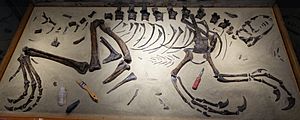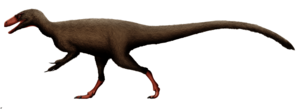Tanycolagreus facts for kids
Quick facts for kids Tanycolagreus |
|
|---|---|
 |
|
| Tanycolagreus holotype, North American Museum of Ancient Life | |
| Scientific classification | |
| Genus: |
Tanycolagreus
|
| Species: |
topwilsoni
|
Tanycolagreus (pronounced Tan-ee-koh-LAG-ree-us) was a type of dinosaur that lived during the Upper Jurassic period. This means it lived about 150 million years ago! It was a theropod, which is a group of meat-eating dinosaurs that walked on two legs. Tanycolagreus lived in what is now North America.
Scientists learned about Tanycolagreus from a special fossil called a holotype. This is the main fossil used to describe a new species. The fossil was given to science by someone who wanted to remain private. You can see it at the North American Museum of Ancient Life in Lehi, Utah. The fossil includes parts of the skull and lower jaws. It also has many bones from the rest of the body, like the legs and tail. Scientists believe this dinosaur was about 3.3 meters (11 feet) long.
Where Tanycolagreus Lived
The fossil of Tanycolagreus was found in a place called the Morrison Formation. This area in North America was once full of different kinds of life. Back then, it was like a savannah with many rivers flowing through it.
Along these rivers, there were forests with conifer trees, ginkgos, and cycads. You could also find tree ferns and tall horsetail plants.
The insects living there were much like the ones we see today. Some termites even built huge nests, up to 30 meters (100 feet) tall! The rivers were home to fish, frogs, salamanders, lizards, and crocodiles. There were also turtles, flying pterosaurs, and crayfish. Small clams lived in the water too. Tiny mammals called monotremes, which were about the size of a rat, also lived near the rivers.
Many dinosaurs, including Tanycolagreus, likely stayed close to these rivers. Scientists have found hundreds of dinosaur fossils in the Morrison Formation. This tells us it was a very busy place for dinosaurs!
Scientists use a method called radiometric dating to figure out how old rocks and fossils are. They found that the Morrison Formation rocks are about 156 million years old at the bottom. The rocks at the top are about 147 million years old. This means the environment lasted for almost 10 million years.
Tanycolagreus Family Tree
Scientists study the bones of dinosaurs to figure out how they are related to each other. This is like building a family tree for dinosaurs, called a phylogeny.
When scientists first studied Tanycolagreus, they thought it looked a lot like another dinosaur called Coelurus. However, Tanycolagreus also had some features that seemed more "primitive." This means they were older traits, like those found in earlier dinosaurs.
Later studies tried to place Tanycolagreus in the dinosaur family tree. One idea was that it might be an early relative of the Tyrannosaurs, like Tyrannosaurus rex. But more recent research has shown that Tanycolagreus is a more "basal" (or early) member of the Coelurosauria group. This means it's an older branch on the family tree of dinosaurs that includes birds and many famous theropods.
Images for kids
See also
 In Spanish: Tanycolagreus topwilsoni para niños
In Spanish: Tanycolagreus topwilsoni para niños





